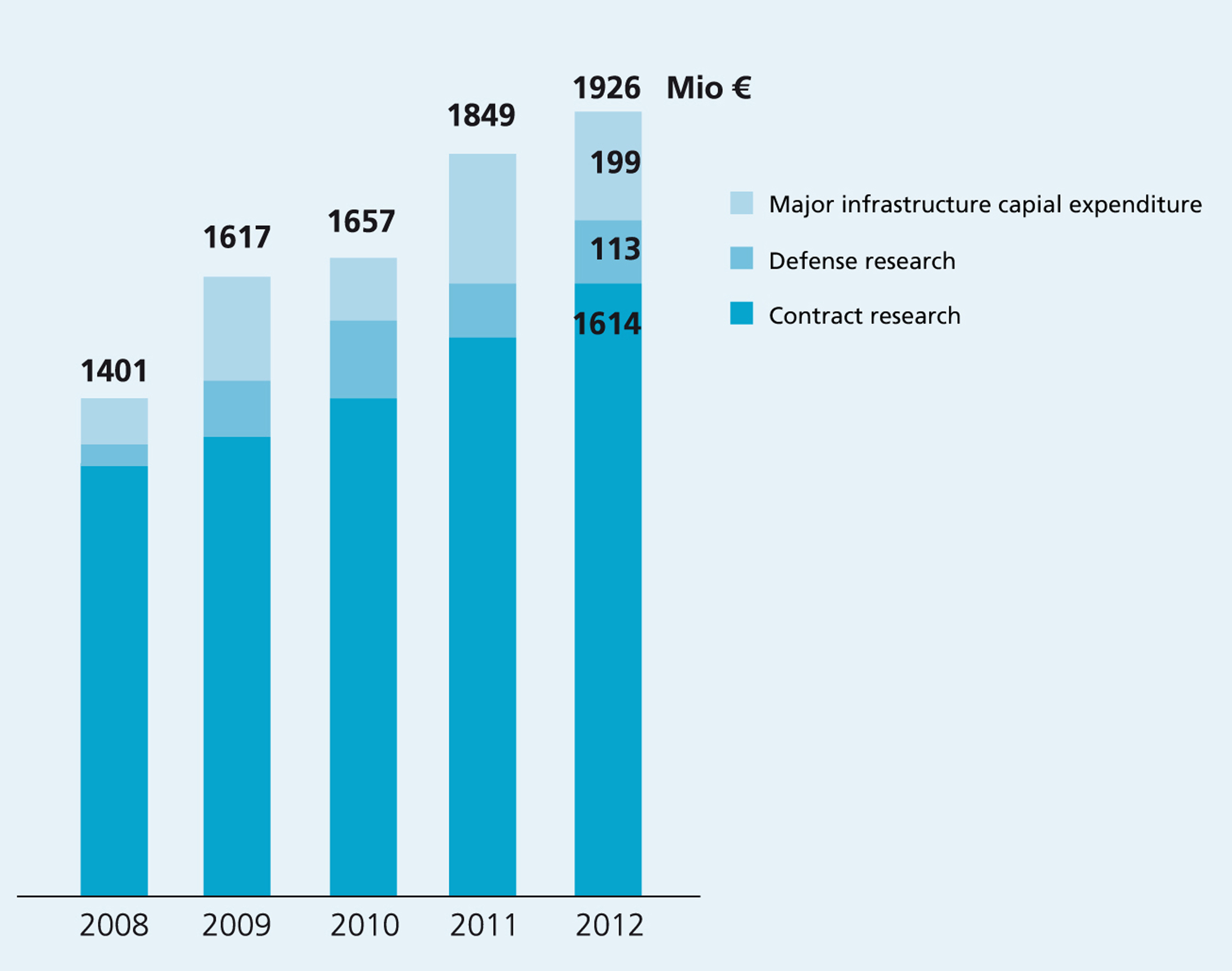Industry demonstrates confidence in Fraunhofer expertise
The Fraunhofer-Gesellschaft continued to grow in 2012, with total business volume up four percent to a new total of 1.9 billion euros. Revenues from research projects with the industry have enjoyed particularly strong growth, increasing by 12 percent, to 453 million euros.
“Our steady growth over the past several years continued in 2012, as the Fraunhofer-Gesellschaft’s business volume rose from 1.849 to 1.926 billion euros,” reports president Professor Reimund Neugebauer, summarizing the results of the 2012 financial year. Business volume is made up of budgeted expenditure on contract and defense research, as well as major infrastructure capital expenditure. Contract research – the main focus for research and development activities – grew by seven percent to 1.6 billion euros. Budgeted expenditure for defense research activities was at 113 million euros. Capital expenditure on infrastructure, at 199 million euros, remained high despite the expiry of various government-funded economic stimulus programs.
Contract research represents the core of the research organization’s work. Budgeted expenditure is financed by a combination of base funding and project revenues. In 2012, the budgeted expenditure for contract research amounted to 1.6 billion euros. “The Fraunhofer-Gesellschaft earns around 70 percent of this sum from its contracts with companies in industry and through publicly funded research projects. Fraunhofer was able to increase these project revenues in the year under review by three percent, to reach a figure of 1.137 billion euros,” explains Senior Vice President Finance, Professor Alfred Gossner. Around 30 percent is provided by the state as base funding, which is earmarked to enable basic research.
Increased revenues from industry
Revenues from industry enjoyed particularly strong growth. Taking license fees into account, these revenues rose by seven percent to reach 570 million euros. “It’s particularly gratifying to note that revenues through research projects from the private sector, which rose from 406 to 453 million euros, have established a new record. This growth testifies to the Fraunhofer-Gesellschaft’s success in aligning itself to the needs of industry,” stresses Fraunhofer president Neugebauer.
In 2012, revenues from projects undertaken in cooperation with the German federal and Länder governments fell by six percent to 382 million euros. This dip was successfully offset by a rapid growth in revenues from projects funded by the European Commission, which rose by 24 percent to 88 million euros.
Defense research activities bring together the expertise of seven Fraunhofer institutes involved in defense and security research. This research aims to give people and their environment the best possible protection against outside threats. Expenditure on defense research rose by 15 percent to 113 million euros.
2012 saw Fraunhofer invest 199 million euros in the infrastructure of its research institutions. Admittedly, this meant a drop in capital expenditure on infrastructure when compared with the high figure of 236 million euros recorded last year. Put into perspective, 2011 was the last year in which German federal and Länder governments made funds available as part of their economic stimulus programs.
Over 1700 more employees
At the end of 2012, the number of Fraunhofer employees exceeded 22,000 for the first time. A total of 1700 additional employees were working for the research organization in 2012 when compared with the previous year. Fraunhofer is one of the most popular employers in Germany. It took the first place in the Randstad Award 2012, making it the most attractive employer among Germany’s 150 biggest companies by number of employees.
Patents and spin-off companies
The Fraunhofer-Gesellschaft is one of the most active and important sources of patent applications in Germany. Last year, its research institutions registered 696 new inventions, of which 499 – in other words, more than 70 percent – led to a new patent application. On average, Fraunhofer files two patent applications every working day. The number of active patents, utility patents and pending patent applications rose to 6103 as of the end of 2012. The number of exploitation contracts grew from 2841 in 2011 to reach 3167 active contracts, with license fees contributing 117 million euros to revenues. Spin-offs represent another main avenue for exploiting industrial propriety rights. In the course of the 2012 financial year, Fraunhofer provided support to 33 new spin-off projects, leading to the foundation of ten Fraunhofer-Gesellschaft spin-off companies.
Significant increase in European revenues
The globalization of science and industry calls for strategic internationalization of the Fraunhofer-Gesellschaft, allowing Germany to benefit as an innovative business location from the very latest existing knowledge and expertise. In 2012, Fraunhofer generated revenues amounting to 233 million euros (not including license fees) with its international partners. The organization was particularly successful in Europe, where revenues climbed 19 percent to 172 million euros. Various contracts in other European countries generated turnover of 84 million euros. Revenues from projects supported by the European Commission rose 24 percent to 88 million euros. Fraunhofer was also able to significantly boost Asian revenues, which grew by 34 percent to 24 million euros.
Research and technology represent the key to innovation, economic strength and a prosperous society. The Fraunhofer-Gesellschaft will continue to help secure Germany’s position as an industrial location.
